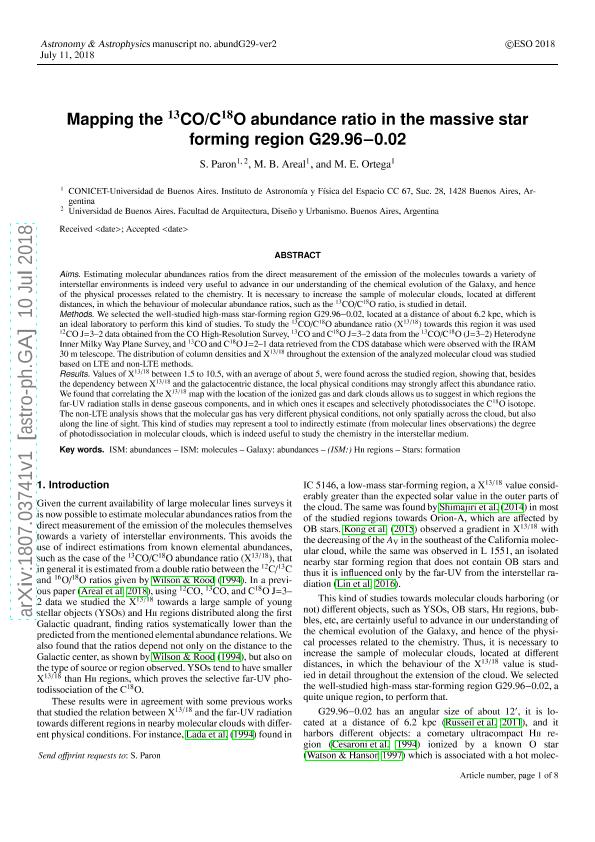Mostrar el registro sencillo del ítem
dc.contributor.author
Paron, Sergio Ariel

dc.contributor.author
Areal, María Belén

dc.contributor.author
Ortega, Martin Eduardo

dc.date.available
2019-10-18T15:55:05Z
dc.date.issued
2018-09
dc.identifier.citation
Paron, Sergio Ariel; Areal, María Belén; Ortega, Martin Eduardo; Mapping the 13CO/C18O abundance ratio in the massive star-forming region G29.96-0.02; EDP Sciences; Astronomy and Astrophysics; 617; A14; 9-2018; 1-8
dc.identifier.issn
0004-6361
dc.identifier.uri
http://hdl.handle.net/11336/86368
dc.description.abstract
Aims. Estimating molecular abundances ratios from directly measuring the emission of the molecules toward a variety of interstellar environments is indeed very useful to advance our understanding of the chemical evolution of the Galaxy, and hence of the physical processes related to the chemistry. It is necessary to increase the sample of molecular clouds, located at different distances, in which the behavior of molecular abundance ratios, such as the 13CO/C18O ratio, is studied in detail. Methods. We selected the well-studied high-mass star-forming region G29.96-0.02, located at a distance of about 6.2 kpc, which is an ideal laboratory to perform this type of study. To study the 13CO/C18O abundance ratio (X13/18) toward this region, we used 12CO J = 3-2 data obtained from the CO High-Resolution Survey, 13CO and C18O J = 3-2 data from the 13CO/C18O (J = 3-2) Heterodyne Inner Milky Way Plane Survey, and 13CO and C18O J = 2-1 data retrieved from the CDS database that were observed with the IRAM 30 m telescope. The distribution of column densities and X13/18 throughout the extension of the analyzed molecular cloud was studied based on local thermal equilibrium (LTE) and non-LTE methods. Results. Values of X13/18 between 1.5 and 10.5, with an average of about 5, were found throughout the studied region, showing that in addition to the dependency of X13/18 and the galactocentric distance, the local physical conditions may strongly affect this abundance ratio. We found that correlating the X13/18 map with the location of the ionized gas and dark clouds allows us to suggest in which regions the far-UV radiation stalls in dense gaseous components, and in which regions it escapes and selectively photodissociates the C18O isotope. The non-LTE analysis shows that the molecular gas has very different physical conditions, not only spatially throughout the cloud, but also along the line of sight. This type of study may represent a tool for indirectly estimating (from molecular line observations) the degree of photodissociation in molecular clouds, which is indeed useful to study the chemistry in the interstellar medium.
dc.format
application/pdf
dc.language.iso
eng
dc.publisher
EDP Sciences

dc.rights
info:eu-repo/semantics/openAccess
dc.rights.uri
https://creativecommons.org/licenses/by-nc-sa/2.5/ar/
dc.subject
GALAXY: ABUNDANCES
dc.subject
HII REGIONS
dc.subject
ISM: ABUNDANCES
dc.subject
ISM: MOLECULES
dc.subject
STARS: FORMATION
dc.subject.classification
Otras Ciencias Naturales y Exactas

dc.subject.classification
Otras Ciencias Naturales y Exactas

dc.subject.classification
CIENCIAS NATURALES Y EXACTAS

dc.title
Mapping the 13CO/C18O abundance ratio in the massive star-forming region G29.96-0.02
dc.type
info:eu-repo/semantics/article
dc.type
info:ar-repo/semantics/artículo
dc.type
info:eu-repo/semantics/publishedVersion
dc.date.updated
2019-10-17T19:10:56Z
dc.journal.volume
617
dc.journal.number
A14
dc.journal.pagination
1-8
dc.journal.pais
Francia

dc.journal.ciudad
Paris
dc.description.fil
Fil: Paron, Sergio Ariel. Consejo Nacional de Investigaciónes Científicas y Técnicas. Oficina de Coordinación Administrativa Ciudad Universitaria. Instituto de Astronomía y Física del Espacio. - Universidad de Buenos Aires. Facultad de Ciencias Exactas y Naturales. Instituto de Astronomía y Física del Espacio; Argentina
dc.description.fil
Fil: Areal, María Belén. Consejo Nacional de Investigaciónes Científicas y Técnicas. Oficina de Coordinación Administrativa Ciudad Universitaria. Instituto de Astronomía y Física del Espacio. - Universidad de Buenos Aires. Facultad de Ciencias Exactas y Naturales. Instituto de Astronomía y Física del Espacio; Argentina
dc.description.fil
Fil: Ortega, Martin Eduardo. Consejo Nacional de Investigaciónes Científicas y Técnicas. Oficina de Coordinación Administrativa Ciudad Universitaria. Instituto de Astronomía y Física del Espacio. - Universidad de Buenos Aires. Facultad de Ciencias Exactas y Naturales. Instituto de Astronomía y Física del Espacio; Argentina
dc.journal.title
Astronomy and Astrophysics

dc.relation.alternativeid
info:eu-repo/semantics/altIdentifier/url/http://adsabs.harvard.edu/abs/2018A%26A...617A..14P
dc.relation.alternativeid
info:eu-repo/semantics/altIdentifier/doi/http://dx.doi.org/10.1051/0004-6361/201833658
Archivos asociados
